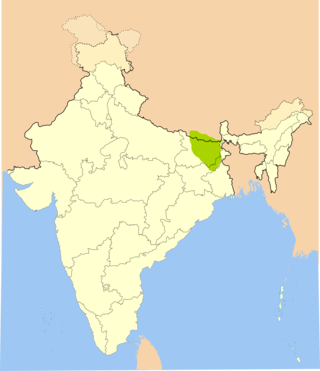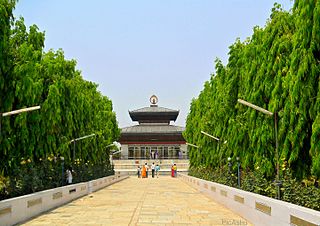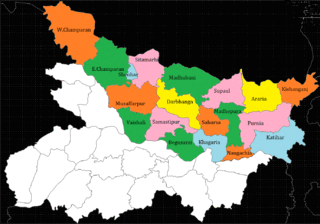Bihari languages are a group of the Indo-Aryan languages. The Bihari languages are mainly spoken in the Indian states of Bihar, Jharkhand, Uttar Pradesh, and West Bengal, and also in Nepal. The most widely spoken languages of the Bihari group are Bhojpuri, Magahi and Maithili.

Mithila is a proposed state in India, comprising the Maithili speaking region of Bihar and Jharkhand. The Maithili language has own traditional script, known as Mithilakshar. It is part of the historical Mithila region. The proposed state will also include Whole Angika and Bajjika speaking districts which are considered to be dialects of Maithili.

Maithili is an Indo-Aryan language spoken in parts of India and Nepal. It is native to the Mithila region, which encompasses parts of the Indian states of Bihar and Jharkhand as well as the Nepalese Koshi and Madhesh Provinces. It is one of the 22 official languages of India. It is the second most commonly spoken language of Nepal. It is also one of the fourteen provincial official languages of Nepal.

Magahi, also known as Magadhi, is a Indo-Aryan language spoken in Bihar, Jharkhand and West Bengal states of eastern India, and in the Terai of Nepal. Magadhi Prakrit was the ancestor of Magahi, from which the latter's name derives.

Vaishali district is a district of Mithila region in the Indian state of Bihar. It is a part of Tirhut division. Vaishali is known for being the birthplace of Mahavira of the Jain religion. Hajipur, its largest city and district headquarters, is known for its banana forest. The district is connected via the NH-77 and NH-322 highways, which connect the state capital Patna, the division headquarters Muzaffarpur, and the eastward district Samastipur.

Sitamarhi is one of the districts in the Mithila region of the Indian state of Bihar, India. Dumra is the administrative headquarters of this district. The district is a part of the Tirhut Division and is located along the border of Nepal.

Kosi division is an administrative geographical unit of Bihar state of India. Saharsa is the administrative headquarters of the division. Currently (2022), the division consists of Saharsa district, Madhepura district, and Supaul district.

Mithila, also known as Tirhut, Tirabhukti and Mithilanchal is a geographical and cultural region of the Indian subcontinent bounded by the Mahananda River in the east, the Ganges in the south, the Gandaki River in the west and by the foothills of the Himalayas in the north. It comprises certain parts of Bihar and Jharkhand of India and adjoining districts of the Koshi Province, Bagmati Pradesh and Madhesh Province of Nepal. The native language in Mithila is Maithili, and its speakers are referred to as Maithils.
Mithila is a geographical and cultural region located in the Indian subcontinent. The native language is known as Maithili and its speakers are referred to as Maithils. The majority of the Mithila region falls within modern-day India, more specifically in the state of Bihar. Mithila is bounded in the north by the Himalayas, and in the south, west and east by the Ganges, Gandaki and Mahananda respectively. It extends into the southeastern Terai of Nepal. This region was also called Tirabhukti, the ancient name of Tirhut.
Hindi is one of the official languages in the Indian state of Bihar. Although Hindustani is the lingua-franca of the region, the majority of the people natively speak one of the Bihari languages.
Bihar has produced a number of poets and writers in its languages like Bhojpuri Maithili language, Magahi language, Angika and Bajjika including Bhikhari Thakur, Heera Dom, Viveki Rai,Satishwar Sahay Verma, Pandey Kapil etc are writers of Bhojpuri, Vidyapati in Maithili. Besides its regional languages, Bihar has also produced writers in English such as Raj Kamal Jha, Amitava Kumar, Tabish Khair, Gunjesh Bond, Abhay K, Kumar Vikram, Siddhartha Chowdhury; and Hindi including Raja Radhika Raman Prasad Sinha, Kumar vansi, Acharya Ramlochan Saran, Acharya Shivpujan Sahay, Divakar Prasad Vidyarthy, Ramdhari Singh 'Dinkar', Ram Briksh Benipuri, Phanishwar Nath 'Renu', Gopal Singh "Nepali", Ramesh Chandra Jha and Baba Nagarjun. Writer and Buddhist scholar Mahapandit Rahul Sankrityayan was born in Uttar Pradesh but spent his life in the land of Buddha, i.e., Bihar. Hrishikesh Sulabh is a short story writer, playwright and theatre critic. Arun Kamal and Aalok Dhanwa are poets.

The Eastern Indo-Aryan languages, also known as Māgadhan languages, are spoken throughout the eastern region of the subcontinent, which includes Bihar, Uttar Pradesh, Jharkhand, Bengal region, Tripura, Assam, and Odisha; alongside other regions surrounding the northeastern Himalayan corridor. Bengali is official language of Bangladesh and the state of West Bengal, Tripura and the Barak valley of Assam while Assamese and Odia are the official languages of Assam and Odisha, respectively. The Eastern Indo-Aryan languages descend from Abahattha, which descends from Magadhan Apabhraṃśa and ultimately from Magadhi Prakrit.
Most of the languages of Bihar, the third most populous state of India, belong to the Bihari subgroup of the Indo-Aryan family. Chief among them are Bhojpuri, spoken in the west of the state, Maithili in the north, Magahi in center around capital Patna and in the south of the state. Maithili has official recognition under the Eighth Schedule to the Constitution of India. The official language of Bihar is Modern Standard Hindi, with Standard Urdu serving as a second official language in 15 districts.

Surjapuri is an Indo-Aryan language of the Bengali-Assamese branch, spoken in Eastern India including North Bengal, West Bengal, and some eastern parts of Purnia division of Bihar, as well as Jhapa District in Nepal, Goalpara Division of Assam in India and Rangpur Division in Bangladesh. Among speakers in some regions, it is known as 'Deshi Bhasa'. It possesses similarities with Kamatapuri, Assamese, Bengali, and Maithili.

Khortha or alternatively classified as Eastern Magahi is a language variety spoken primarily in the Indian state of Jharkhand, mainly in 16 districts of three divisions: North Chotanagpur, Palamu division and Santhal Pargana. Khortha is spoken by the Sadaans as native language and used by the tribal as a link language. It is the most spoken language variety of Jharkhand.

Angika is an Eastern Indo-Aryan language spoken in some parts of the Indian states of Bihar and Jharkhand, as well as in parts of Nepal.

North Bihar is a term used for the region of Bihar, India, which lies north of the Ganga river.

Mithila State Movement is a movement advocating a separate Mithila state in India. This movement gained momentum in 1902 AD when Sir George Grierson, an official of the British Indian government, prepared a map of Mithila state by conducting a language-based survey. In 1881 AD, the word Mithila was added to the dictionary of the British India government. According to the founder, president Dr. Dhanakar Thakur of the International Maithili Council in the proposed Mithila state, 24 districts of Bihar and six districts of Jharkhand, a total of 30 districts, have been included, which has a population of about 70 million. At the same time, the area is 70 thousand square km.
Aina-i-Tirhut is a history book written by Bihari Lal Fitrat in Urdu language. It is one of the first attempt to cataloguing and compiling the history of Mithila, Bihar. It was first published in 1883 by Bahar Kashmir Press, Lucknow. The book full name is Mithila in the nineteenth century: Aina-i-Tirhut of Bihari Lal "Fitrat".












